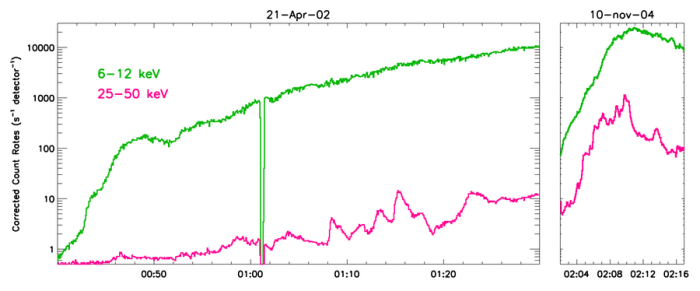Slowly but surely towards the huge amount of energy I
| Nugget | |
|---|---|
| Number: | 162 |
| 1st Author: | Urszula Bąk-Stęślicka |
| 2nd Author: | Tomasz Mrozek, Sylwester Kołomański |
| Published: | 31 October 2011 |
| Next Nugget: | X-ray and H-alpha Flare Impulses |
| Previous Nugget: | Quasi-Periodic Pulsations: Fermi/GBM Results |
Introduction
Solar flares may have complicated structures and time developments, but since Skylab days we have distinguished between "impulsive" and "gradual" classes. A Long Duration Event (LDE) is a flare characterized by a slow decrease of the soft X-ray (SXR) emission. The decay phase of an LDE may last more than a day. Some LDEs may also have an unusually long rising phase that may lasts more than 30 minutes. We refer to this type of LDE as a "slow long-duration event" (SLDE). During the rise phase of an SLDE there is no typical impulsive phase [1]. Instead of short pulses, we observe a gradual increase of hard X-ray (HXR) emission and/or a smooth, broad (several minutes long) bursts of HXR emission (see Figure 1). RHESSI's first X-class flare was just such an event.
Chronologically the first studies of SLDEs were based on Yohkoh/SXT images [2]. These studies provided us with the basic observational characteristics of SLDEs:
- most SLDEs occur in high or mid-high structures,
- loop-top sources are characterized by low temperature (T<10 MK), low density (N ≈ 1010 cm−3) and large size (r > 7 × 108 cm),
- the heating rate of plasma is small, below 1 erg cm−3s−1 and,
- the heating rate decreases very slowly with time after reaching its maximum value.
A detailed analysis of SLDEs in the hard X-ray range requires high spectral resolution, much better than the resolution provided by the Yohkoh/HXT.
This requirement is fulfilled by RHESSI, which allows us to investigate spatially-resolved HXR emission of SLDEs with 1 keV energy resolution.
This energy resolution enables the estimation of physical parameters in SLDEs through imaging spectroscopy.
The parameters thus obtained (e.g., temperature and emission measure) can be used to investigate the energy balance/budget.
Data Analysis
For our analysis we selected six limb or near-the-limb SLDEs, with rise phases lasting between 25 to 150 min. RHESSI light curves, GOES/SXI with the RHESSI contours, and the RHESSI spectrum (for the flare with the longest rising phase) are shown in Figure 2. The images were reconstructed with the PIXON algorithm. We used time intervals of 20 – 40 s and narrow energy intervals of 1 – 2 keV. In our analysis we concentrated on coronal sources, so-called loop-top sources only. For each such source we estimated the size (area projected on image) and altitude above the photosphere. Next, we performed a spectroscopic analysis, using the standard RHESSI software, to obtain the physical parameters. These parameters were used as an input data for a calculation of the heating rate. It was assumed that a change in the thermal energy of a loop-top source is due to expansion, radiation, conduction (cooling processes) and heating. Expressed in the form of an equation,
Observed change of thermal energy = adiabatic expansion – conductive cooling – radiative cooling + heating rate
Knowing the change of the loop-top thermal energy and the values of the three cooling processes we can calculate how efficiently the source was heated. As an additional parameter describing the temporal evolution of the heating rate. we calculate the characteristic time, τs, of the decrease of the heating rate (EH) after it reaches its maximum value:

Results
Our study [3] dealt with six SLDEs, with the following results:
- The character of the loop-top emission: we find a thermal component to be dominant, however for four of the six events we observed significant non-thermal emission
- The heating rate of the plasma: the values obtained are not high, usually below 10 erg cm3s-1, but larger than those obtained from the earlier SXT observations. This difference is caused by the fact that SXT had less sensitivity to higher-temperature plasma (> 10 MK).
- The time evolution of the heating rate: the long duration of the rise phase of an SLDE is consistent with a very slow decrease of the heating rate during this phase. In most cases the characteristic time τ is larger than 1000 s.
- The total thermal energy released during the rise phase: the low limit of the total energy released during the rising phase was calculated under the following assumptions: (a) the heating rate is constant throughout the entire rise phase and equal to its minimum measured value, (b) the loop-top volume was calculated from the mean area of the source, A, as seen in images, assuming a sphere with a constant volume during the whole rise phase. For the analyzed events we obtained at least about 1031 erg as the total thermal energy released during the rise phase.
Conclusions
Do the "slow LDEs" represent different physics, not found in ordinary flares? Despite the low value of the heating rate, during the whole rise phase of SLDE the total released energy is huge. In our examples it is around 1031 – 1032 erg. This value is larger, by at least an order of magnitude, than the total energy released during the rise phase of a short-rise flares of comparable GOES magnitude. In some cases no detectable HXR (nor, then, intense particle acceleration) may have occurred. It remains to be seen whether this signifies different physical processes.
References
[1] "Hard X-rays from 'Slow LDEs'"
[2] "Investigation of X-Ray Flares with Long Rising Phases"
[3] "Energy Release During Slow Long-Duration Flares Observed by RHESSI"

